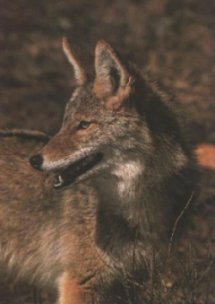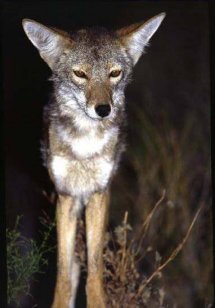The coyote's name is derived from the Aztec word
"coyotl". It is a member of the dog family (canids)
which includes wolves, dogs and foxes, and resembles
a small German Shepherd. Adults coyotes weigh an average
of 20 to 35 pounds, with males being about 4 pounds
heavier than females. An adult coyote is four to five
feet long from the tip of its nose to the tip
of its tail.
In Nebraska, coyote pelts show a great
variety of color and texture. Coyotes generally have
a coarse coat that is brownish gray to buff in
color, while coyotes from the Sandhills and Panhandle are
much lighter gray with dense, soft underfur.

Coyotes have bushy black-tipped tails, broad, pointed, erect
ears and yellow eyes. They have relatively large brains,
and exceptional senses of smell, sight and hearing.
Although coyotes avoid wolves and dogs under normal conditions,
they occasionally mate with them and create hybrid offspring
that are usually larger than a typical coyote. This
usually happens where wolf densities are low or on the
edge of the coyote's range.
Coyotes are extremely adaptable and live in a wide variety
of vegetative types, from grassland to northern boreal
forest. Almost any area that supports good populations of
small prey will support coyotes. As prey abundance increases,
coyote abundance generally increases.
Coyotes require a
minimum of shelter during most of the year. They usually simply
curl up in a concealed, protected spot, though they do
use dens for whelping and rearing pups. A coyote seldom
digs its own den, instead, but will use someone elses
if not vacated.

Both parents help care for young and may mate for
life.
A mated pair defends its home range from adjacent
pairs but is somewhat tolerant of unmated transient coyotes
that pass through the range. Unmated transient coyotes move
great distances and comprise up to 20 percent of
the total coyote population. A coyote marks his territory
with scent by depositing droppings and urine on the perimeter
of the area.
Coyotes take advantage of seasonal changes in the abundance
of food items. Rabbits, deer fawns, various plants and assorted
birds and invertebrates are important summer food. Their
winter diet emphasizes larger prey, such as deer, livestock,
rabbits and hares. Occasionally, an individual coyote learns that
sheep, lambs and calves are easy prey.
Coyotes reproduce once a year. Pairs are formed and
breeding occurs in January-February. Coyotes are capable of
breeding at one year of age but not often. Most
are two years old when they breed for the first
time. Pups are born nine weeks after breeding occurs.
The litter size depends on the age of the mother
and the amount of available prey in the area. There
are usually four to seven pups in a litter under
average conditions.

As many as 50 to 70 percent of all juvenile coyotes die
before they reach adulthood. Those that become adults typically
live three to five years, and 30 to 50
percent of the adult population dies each year.
Under most conditions, human-related causes, including hunting,
trapping and vehicle collisions are responsible for most
coyote mortality. Important diseases and parasites that effect
coyotes include canine distemper, canine hepatitis and
heartworm. Surprisingly, rabies is not an important disease in
coyotes, although they are susceptible to that disease.
The coyote is among the top three wildlife species that
are responsible for the killing of livestock, sheep and young
calves. Attempts to control losses involve short-term coyote
population reduction and the removal of offending individuals
by shooting, trapping, or poisoning.
Their pelts valued at
$521,000. Such a beautiful animal to end up
in fur coats.
Home
Wolves
Wolf Dogs
Buffalo
Eagles
Save the Wolves
Call of the Wild
Coyote
Iroquois Nation
Christmas
Email Me